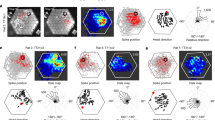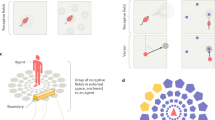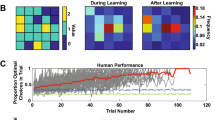Abstract
Desert ants returning from a foraging trip to their nest navigate both by path integration and by visual landmarks1,2,3. In path integration, ants compute their net distance and direction from the nest throughout their outward1 and return4 journeys, and so can always return directly home from their current location1. As the path-integration vector is updated over the entire journey, we call it a global vector. On a familiar route, when ants can steer by visual landmarks, they adopt a fixed and often circuitous path consisting of several separate segments that point in different directions2,3,5. Here we show that, as in honeybees6,7,8, such multisegment journeys are composed partly of stored local movement vectors, which are associated with landmarks and are recalled at the appropriate place. We also show that a local vector learnt at one value of the global vector can be recalled at many values, and that expression of the global vector is temporarily inhibited while the local vector is used. These results indicate that the global vector is ignored during navigation through familiar, cluttered territory, but that it re-emerges to take the ant home once the insect leaves the clutter and other guidance strategies cease to operate.
This is a preview of subscription content, access via your institution
Access options
Subscribe to this journal
Receive 51 print issues and online access
$199.00 per year
only $3.90 per issue
Buy this article
- Purchase on Springer Link
- Instant access to full article PDF
Prices may be subject to local taxes which are calculated during checkout




Similar content being viewed by others
References
Wehner, R. & Wehner, S. Insect navigation: use of maps or Ariadne's thread. Ethol. Ecol. Evol. 2, 27–48 (1990).
Collett, T. S., Dillmann, E., Giger, A. & Wehner, R. Visual landmarks and route following in desert ants. J. Comp. Physiol. A 170, 435–442 (1992).
Wehner, R., Michel, B. & Antonsen, P. Visual navigation in insects: coupling of egocentric and geocentric information. J. Exp. Biol. 199, 129–140 (1996).
Schmidt, I., Collett, T. S., Dillier, F.-X. & Wehner, R. How desert ants cope with enforced detours on their way home. J. Comp. Physiol. A 171, 285–288 (1992).
Rosengren, R. Route fidelity, visual memory and recruitment behaviour in foraging wood ants of the genus Formica (Hymenmoptera, Formicidae). Acta Zool. Fenn. 133, 1–106 (1971).
Collett, T. S. & Baron, J. Learnt sensori-motor mapings in honeybees: interpolation and its possible relevance to navigation. J. Comp. Physiol. A 176, 287–298 (1995).
Menzel, R., Geiger, K., Joerges, J., Müller, U. & Chittka, L. Bees travel novel homeward routes by integrating separately acquired vector memories. Anim. Behav. 55, 139–152 (1998).
Srinivasan, M. V., Zhang, S. W. & Bidwell, N. J. Visually mediated odometry in honeybees. J. Exp. Biol. 200, 2513–2522 (1997).
Baerends, G. P. Fortpflanzungsverhalten und Orientierung der Grabwespe Ammophila campestris. Tijdschr. Entomol. 84, 68–275 (1941).
Müller, M. & Wehner, R. Path integration in desert ants, Cataglyphis fortis. Proc. Natl Acad. Sci. USA 85, 5287–5290 (1988).
Collett, T. S. & Rees, J. A. View-based navigation in hymenoptera: multiple strategies of landmark guidance in the approach to a feeder. J. Comp. Physiol. A 181, 47–58 (1997).
Wehner, R. & Srinivasan, M. V. Searching behaviour of desert ants, genus Cataglyphis (Formicidae, Hymenoptera). J. Comp. Physiol. 142, 315–338 (1981).
Acknowledgements
We thank F.-X. Dillier for help and P. Graham for comments. Financial support came from the BBSRC, the Human Frontiers Science Program and the Swiss National Science Foundation.
Author information
Authors and Affiliations
Corresponding author
Rights and permissions
About this article
Cite this article
Collett, M., Collett, T., Bisch, S. et al. Local and global vectors in desert ant navigation. Nature 394, 269–272 (1998). https://doi.org/10.1038/28378
Received:
Accepted:
Issue Date:
DOI: https://doi.org/10.1038/28378
This article is cited by
-
Modeling the movement of Oecophylla smargandina on short-length scales in an unfamiliar environment
Movement Ecology (2023)
-
Two simple movement mechanisms for spatial division of labour in social insects
Nature Communications (2022)
-
No coordination required for resources allocation during colony fission in a social insect? An individual-based model reproduces empirical patterns
Animal Cognition (2022)
-
Intellectualizing know how
Synthese (2021)
-
Spatial cognition in the context of foraging styles and information transfer in ants
Animal Cognition (2020)
Comments
By submitting a comment you agree to abide by our Terms and Community Guidelines. If you find something abusive or that does not comply with our terms or guidelines please flag it as inappropriate.



